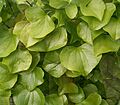Hottentot bread facts for kids
Quick facts for kids Hottentot bread |
|
|---|---|
 |
|
| Scientific classification | |
| Genus: |
Dioscorea
|
| Species: |
elephantipes
|
The elephant's foot plant, also known as Dioscorea elephantipes or Hottentot bread, is a unique flowering plant. It belongs to the Dioscorea family. This plant naturally grows in the dry inland areas of South Africa.
Contents
About the Elephant's Foot Plant
The elephant's foot plant is a type of climber that loses its leaves every year. It gets its name from its huge, lumpy stem, which looks a bit like an elephant's foot. This stem is called a tuber. It grows very slowly, but it can become quite large. Some tubers can be over 3 meters (10 feet) around and nearly 1 meter (3 feet) tall above the ground!
This large tuber is full of starch. That's why it's also called "Hottentot bread." However, you can't just eat it. The plant contains natural compounds that need special processing to make it safe to eat.
Flowers and Growth Cycle
The elephant's foot plant usually grows during the winter. It sends out thin, leafy climbing shoots. In winter, around May or June in its natural home, it produces greenish-yellow flowers with dark spots.
These plants have separate male and female flowers. This means that male flowers grow on one plant, and female flowers grow on a different plant.
Where the Plant Lives
This plant naturally lives in the dry, inland parts of the Cape region in South Africa. You can find it from the Northern Cape, near Springbok, down to the Clanwilliam and Cederberg areas. It also grows eastwards through places like Graaff Reinet, Uniondale, and Willowmore, all the way to Grahamstown.
Recently, scientists found it again in a part of the Northern Cape Province. They were collecting seeds for the Millennium Seed Bank Project. This project helps to save seeds from plants all over the world.
In its natural home, the elephant's foot plant often grows on rocky slopes that face north or east. It prefers soils made of quartz or shale.
Growing Your Own Elephant's Foot Plant
It's not too hard to grow this plant, but it needs specific care. The most important thing is that it needs very rocky, well-draining soil. It also doesn't need much water. Remember, it loses its leaves in the summer. This is when the plant rests and needs less water. The plant has received the Royal Horticultural Society’s Award of Garden Merit. This award means it's an excellent plant for gardens.
How to Water Your Plant
The plant will tell you when it needs water! When new green shoots appear from the big stem (the caudex), you can water it regularly. Keep watering until the green shoots start to dry up and die back. This means the plant is going into its summer rest period. During this time, you should water it much less often. Wait until new growth appears again before watering regularly.
The plant's watering cycle can be a bit tricky to predict. But usually, you will water it more in winter and spring, and keep it dry during its summer rest.
Sunlight Needs
In nature, the large stem of the plant is often hidden in the shade under other plants. Only its leafy vines reach up to the sunlight. Because of this, the big stem is sensitive to too much heat and direct sun. It's best to place it where it gets dappled sun or partial shade. However, the green vine parts love sunlight and will grow well if they can reach partial or full sun.
Best Soil for Growth
This plant naturally grows on rocky slopes. So, it needs soil that drains water very well. At least half of the soil mix should be made of rocky or mineral parts.
Temperature Tolerance
When grown in temperate areas, the elephant's foot plant can handle temperatures as low as -4°C (25°F) in its natural habitat.
Gallery




